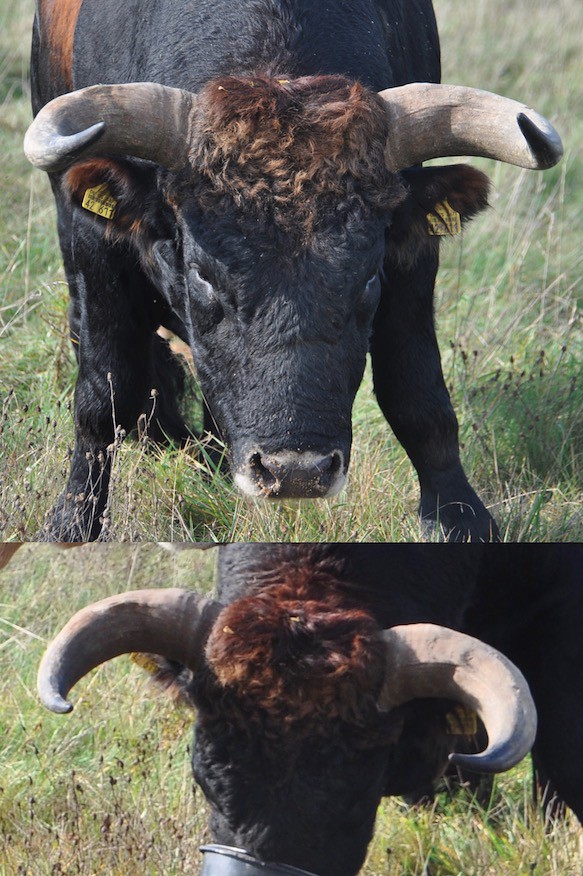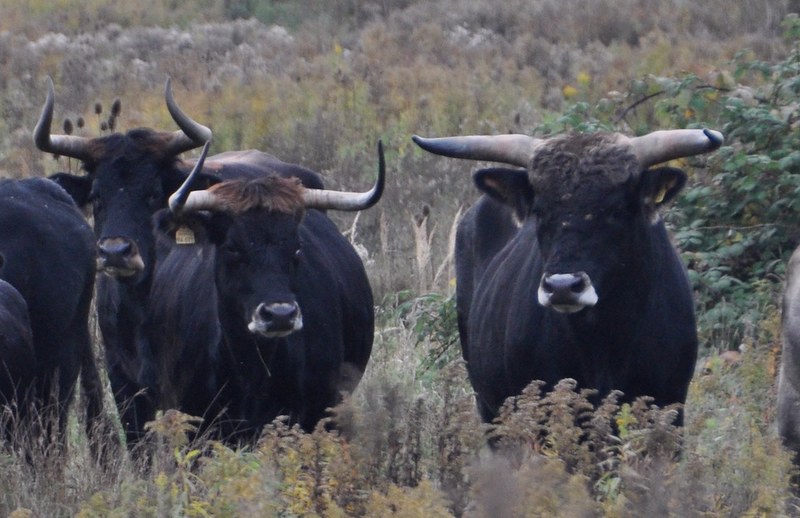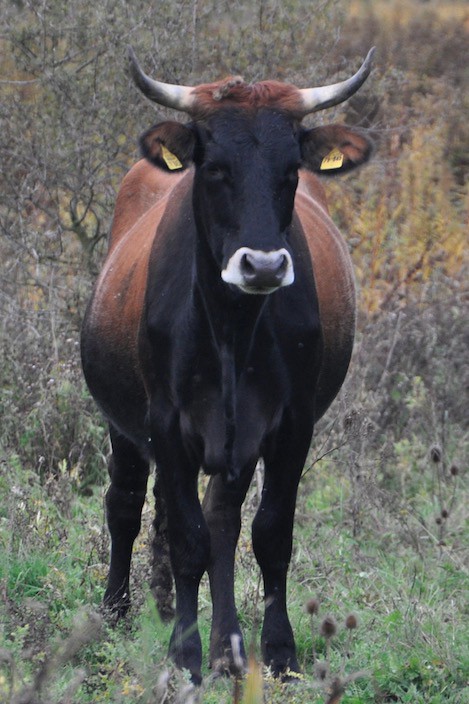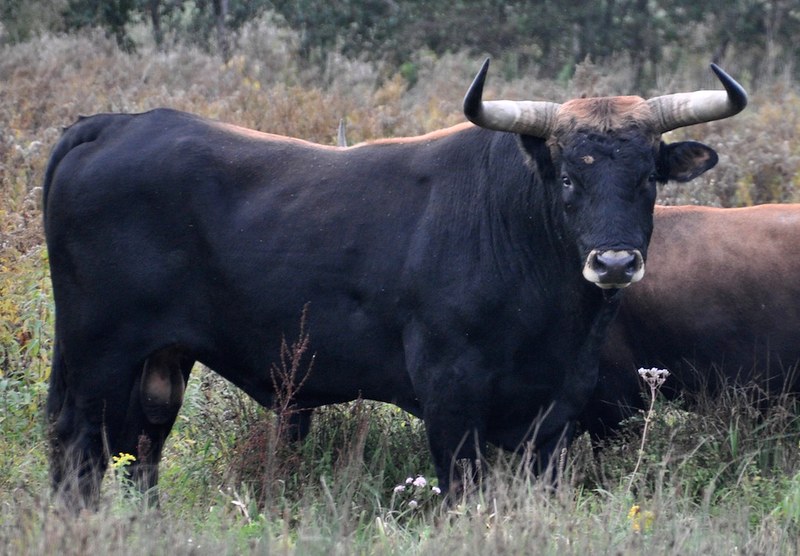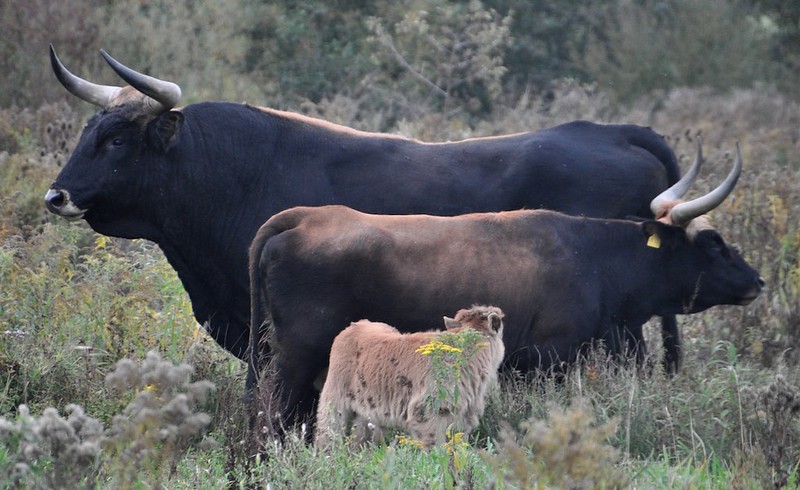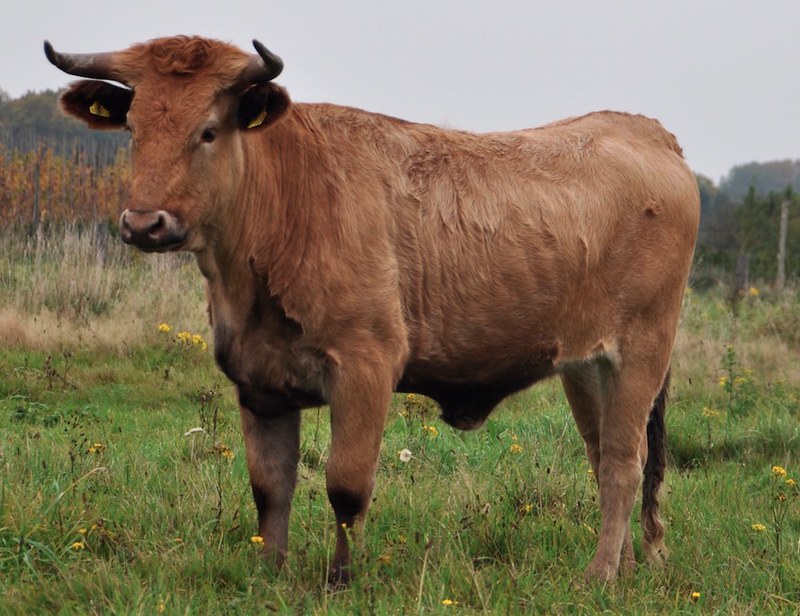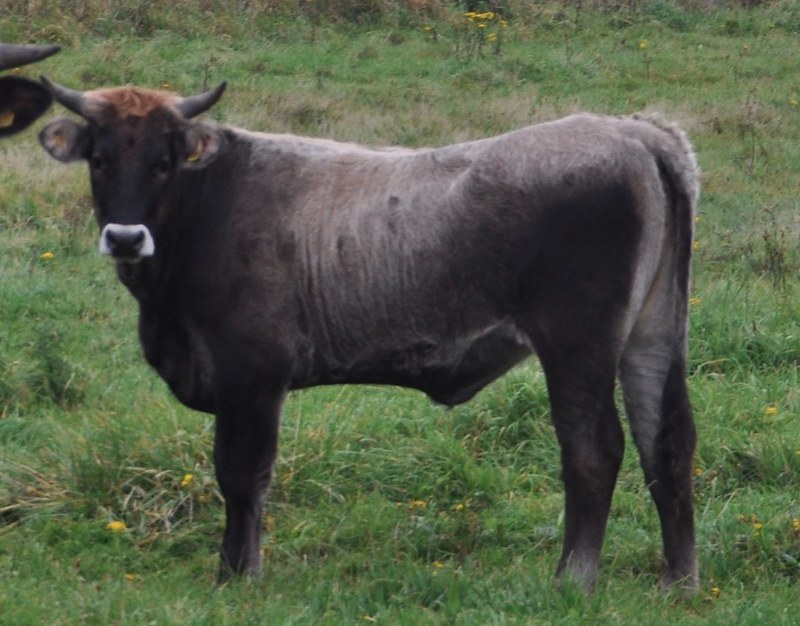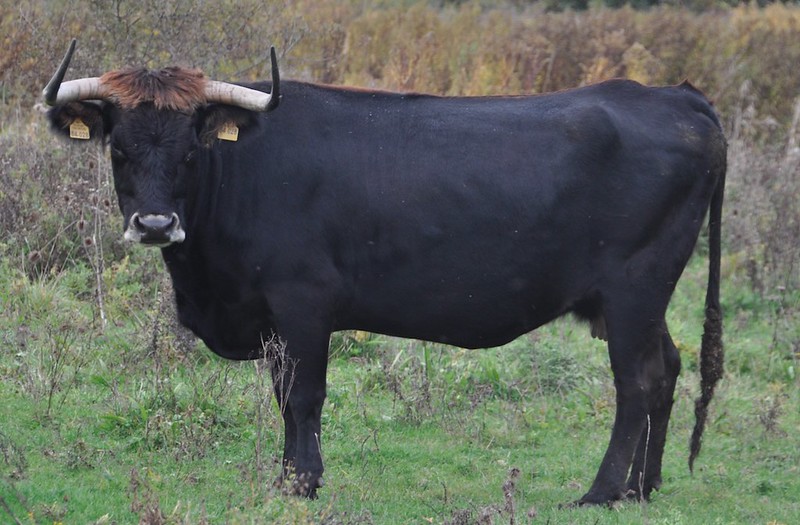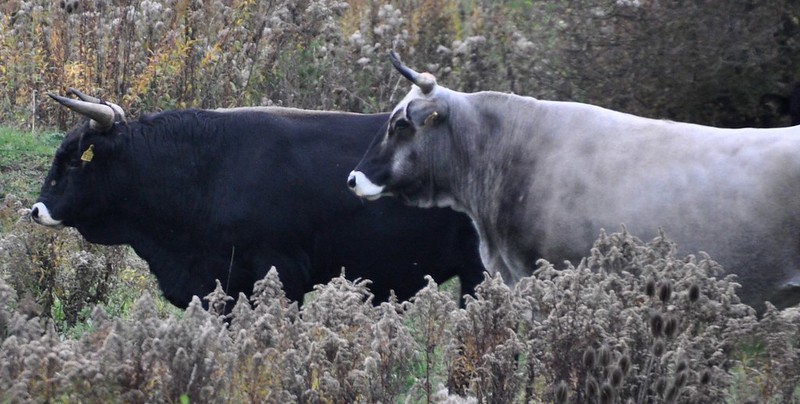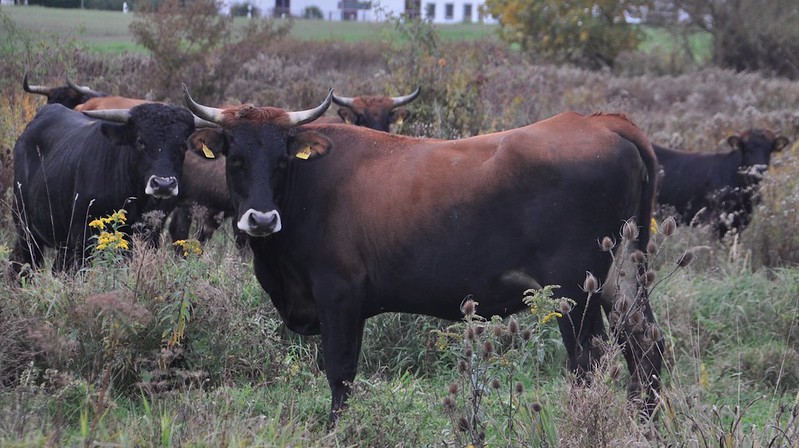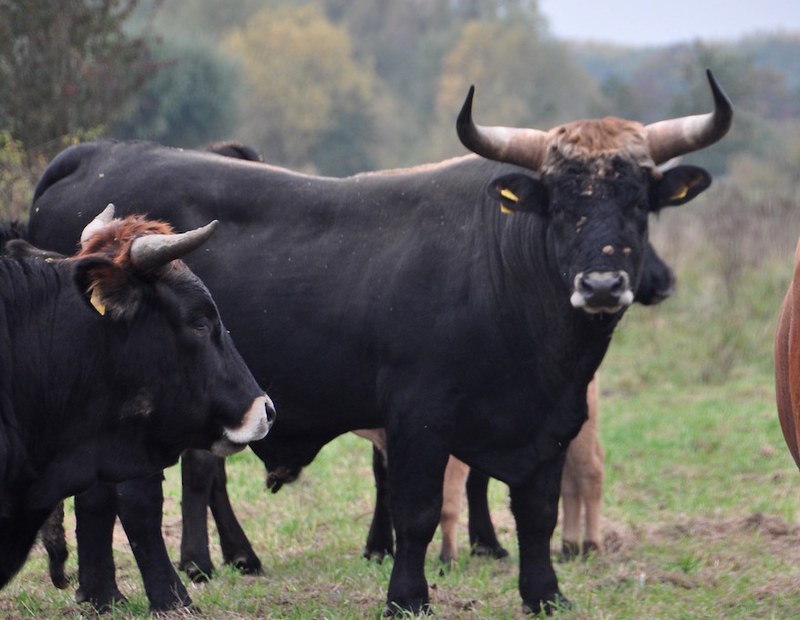The
Lippeaue reserve is the largest Taurus cattle breeding site in Germany and
where Taurus cattle had their start in 1996. Crossbreeding with Chianina,
Sayaguesa and also Lidia had a very positive effect on the authenticity of Heck
cattle as an aurochs substitute. In 2013, I met with Margret Bunzel-Drüke and
Matthias Scharf from the Arbeitsgemeinschaft Biologischer Umweltschutz (ABU) to
take a look at the Taurus cattle living in the Lippeaue reserve and to discuss.
Now, two years later, I went to the Lippeaue once again to see how the herd
developed and progressed, and we met again. Just like in 2013, it was a very
enjoyable, interesting and informative trip!
 |
| Part of the herd at Hellinghauser Mersch |
I had so
much material to go on that my post got ever longer (11 word pages), so I
decided to split it up. The horses of the Lippeaue will be covered in an own
post.
Why are the
Lippeaue herds so interesting to me? Because they serve as a kind of case study
to me; these Taurus cattle are easily accessible to me, all of the individuals
are identifiable thanks to their ear marks and their ancestry is documented. You
see how certain breed combinations work out and how many ways there are, how
coincidental heredity is, as much as how the population is progressing since
the start of crossbreeding in 1996. Apart from that, they are on average really
aurochs-like and all their founding breeds are good in their own respects. Of
course, as many beautiful and qualitative individuals have been born, as much
also went to the butcher – that’s heredity. When you read that certain
individuals were or are going to be removed, “removed” does not always mean
they are going to be slaughtered. The better ones are usually sold to other
breeders.
This time I
saw all five herds (Hellinghauser Mersch, Klostermersch-Süd,
Klostermersch-Nord, Disselmersch, Kleiberg). Twelve animals were sold one day
before I arrived, and the herd currently numbers 101 individuals according to
the current stock list. But mind that 53 are below the age of two years. Since
2013 young individuals grew up, some in a quite satisfying way, others were
removed, breeding bulls were moved, removed or replaced, and also a number of
new genetic combinations were born. I am going to go through the herds one by
one.
As to how
the herd progressed compared to 2013, the span of two years is not sufficient
to watch considerable differences – it is not even one generation span. But
what I intended to look at, and saw, is which individuals were kept in the herd
and how those individuals that looked interesting to me back then have
developed in the meantime.
Unfortunately
the weather was not as warm and sunny as the last time, so the recent photos
are not as shiny and high-resoluted as those from 2013 are. Nevertheless, I
am satisfied with most of the shots.
The cattle primarily
serve as tool in the reserve, and breeding them towards an aurochs-like
appearance is actually a kind of “side project”. Therefore there are some
limitations. First of all, area is limited, and consequently the population
number as well (they have both a minimum and maximum). And so it is not always
possible to keep as many good animals as you want. Another thing is money and
bureaucracy. It would cost a lot of money and effort to pick the best cattle
from anywhere over the world for breeding, f.e. Corriente. Even artificial
insemination would not be easy, because the cows have to be tame enough for
that. Due to the restrictive laws in the EU, its even rather difficult to move
animals within a country, let alone between European countries. Because of the
limited amount of space and money, it is not always possible to try breeding
strategies that might be more promising than the “classical way”. Because,
again, breeding-back is only a site project of restorative grazing in the
Lippeaue. The primary function of the herds is their positive effect on the
ecosystem in this nature reserve.
Nevertheless
we discussed some ideas for breeding strategies, such as replacing bulls and
cows at faster rate to speed up the progress of the herd, f.e. to exchange breeding
bulls once in four years. I was told that the problem with that idea is that it
takes its time until one can see how good the animal is going to get. Horn growth
and body shape are not completed before at least the age of four, as well as
body size. Setting up an extra herd for young bulls might be a desirable idea,
but the problem is that there is not enough space for it. An inbreeding-based
breeding strategy based on “true F-generation” mating (as described here) would
have its pro’s and con’s. Inbreeding of that kind would certainly lead to
stabilization, but also to a high dropout rate due to diseases and unsatisfying
phenotypes. Many of those animals would not be of interest for other breeders,
and that would not be affordable for the ABU.
So they
have to stick with the “classical” breeding method: using a breeding bull with
desirable traits, and selecting out the unsatisfying animals.
You might
ask then, why not doing stronger selection if other strategies are probably not
feasible? Because, just like the area should not be over-crowded they also have
to maintain a certain population number for efficient grazing. So a certain
quantity of the “ugly ones” has to stay in the herd as well.
Not only
that, you also have to keep an eye on the social structure within the herds. In
grazing projects, zoos or pastures of private breeders, groups of cattle with
different behaviour and personality are put basically randomly together on a
confined area. In nature, cattle form herds in a way that works best and
arrange functional social structures for themselves. But in this situation, the
cattle live together in a confined space if they want or not. So there is
potential for conflicts. Some individuals are stabilizing elements in a herd,
others might be even destabilizing. Therefore you also have to consider the
social structure within the herd, disrupting it might lead to conflicts.
Another
issue is temperament. It varies from individual to individual within the
population. Of course does the influence of Lidia increase the risk of having a
nervous and hot-tempered animal, but there are also Lidia influenced cattle
that are comparably calm while some of those without Lidia might also turn out
to be “on the nervous side”. You might discuss if nervous, cautious or
hot-tempered behaviour is the more “natural” state or not (surely true aurochs
were no pets). And some of these might also have some really good looks. But:
one has to work with those cattle, and handle them. The law dictates blood
samples, ear marks et cetera. It is not a good idea to keep an animal that
literally explodes when being examined or transported and afterwards tries to
harm or kill you. So there is no space for overly nervous and hot-tempered
individuals, no matter how beautiful they are. That’s pragmatic, but everyone
would do so (after all, it is no coincidence that most grazing projects work
with domestic cattle instead of wisent). I would not say that these particular
Taurus individuals are necessarily “aggressive”. I guess no Taurus bull or cow
would attack without a reason, and some cattle do react quite “domestic” when
being handled, others less. And honestly, I suspect that most other cattle
breeds, at least the primitive ones, would not react differently living under
the same circumstances.
So breeding
would be way easier if there was a large area accessible that has the capacity
to support a large quantity of cattle. The animals would be able to form herds
themselves, so that one would not have to pay too much attention on social
structure. Temperament would also be no big problem anymore if the population
gets a special status like that in the Oostvaardersplassen (it is, however, in
question for how long that status will be maintained in the future,
unfortunately) so that annual handling is no problem anymore. And large
quantities would enable stronger selection. Another advantage would be the
partial natural selection that is the consequence of bulls fighting for their
breeding rights plus female selection of “sneakers”.
But
unfortunately, a scenario like this is probably a dream. Or at least not in
sight.
What makes
selection tricky is that different people have different priorities. The goal
of Taurus cattle is and was to surpass Heck cattle in size and horn shape, also
to improve their elegance. Now, Heck cattle is surpassed – but that does not
mean that all aurochs traits have been achieved satisfyingly. My personal
priorities are size and body shape/proportions, because they are strikingly
different from most modern day cattle. I also appreciate sexual dimorphism very
much and I am dislike diluted colour variants. Margret, on the other hand,
focuses more on horn curvature because the aurochs – as we all know – had a
horn shape that was also very characteristic. I consider bull sizes from
160-165cm upwards satisfying, but not below. Of course it is legitimate to be
satisfied with bulls ranging from 150-160 cm as well, since not all aurochs
were giants (yet still my dream is a 170cm bull…). They tolerate the colour
saddle in bulls, which is something I would not do (reduced sexual dimorphism),
but I was told that only about one in ten or eight bulls have a saddle (so if a
breeding bull has this trait, it is not because it is widespread in the
population but because the bull was chosen for other, good traits). Where we
agree is that there is room for colour shades in the coat colour of the cows –
written and artistic sources are not all too precise about that, and
wildtype-coloured cows occur in various shades that all look believable, and
perhaps there was regional variation. But I, personally, think this colour shade for example shade is too light. On the other hand, colour is controlled by only
a few loci so it is not as hard to breed as other traits like body shape or
size. We agree that black cows can be tolerated, as long as they are not too
common in the herd (f.e. 50% would definitely be to high).
 |
Lucio, now dead, a very large Sayaguesa x Heck bull and one of the founding individuals.
Next to him, a pure Heck cow - notice the size difference. Photo © Martin Scharf. |
I have
always been keen on knowing the size of Taurus cattle. Lucio, a beautiful but
massive Heck x Sayaguesa, one of the first Taurus bulls that were born, was very
large and measured somewhere between 160-165cm. I tried several times to
calculate the size of Luca, the Heck x Chianina bull whose skull is hanging onmy wall, using photos and its horn span. The result I considered most reliable
was 148cm, but I was told that must have been incorrect. Luca was described as
a very large one that was probably the same size as Lucio.
To get some
more data, I took a yardstick with me and we were able to measure 3 more
individuals that were trustful enough. By the way, I had the opportunity to
stroke two cows and a calf, which was nice.
The next post is going to cover the herds and the current population as a whole. With, as promised, lots of photos.
For the next part, go here.

